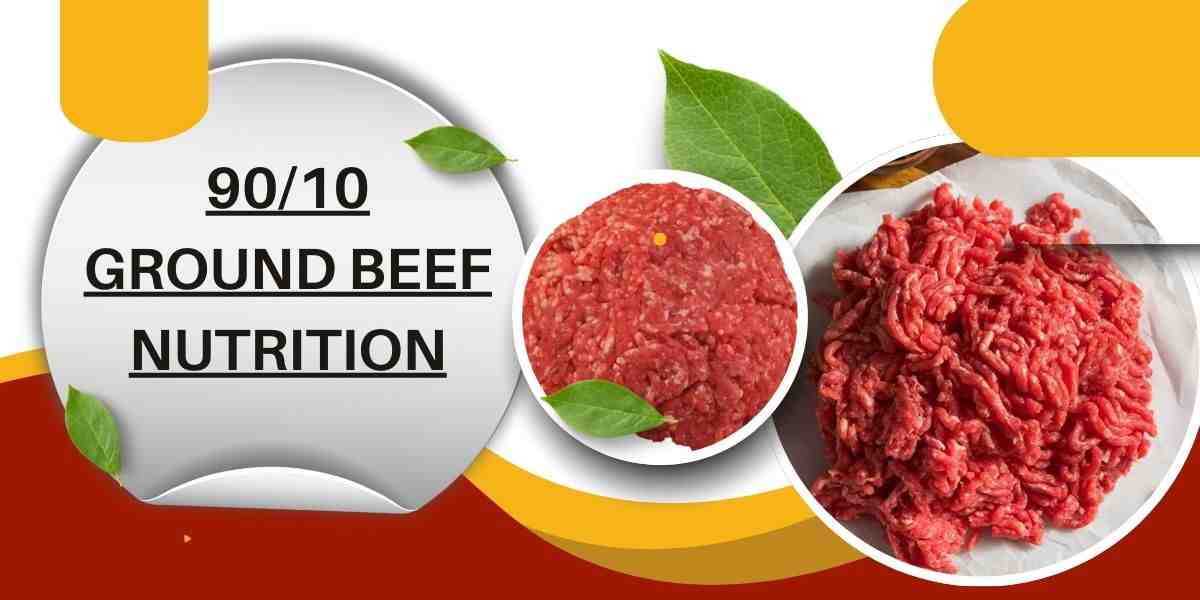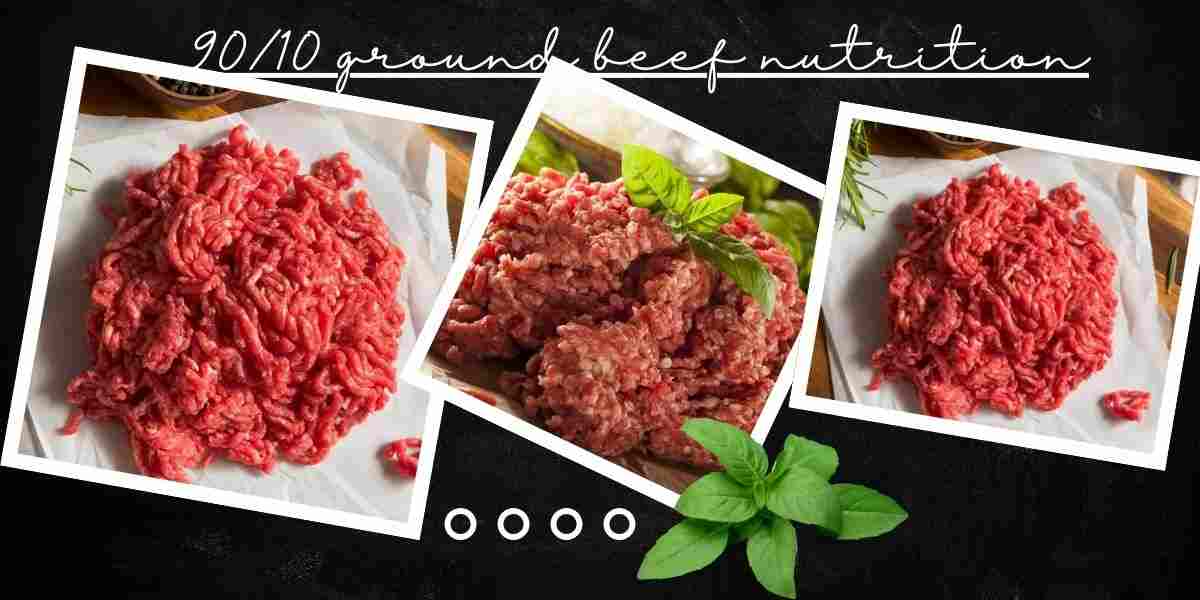90/10 Ground Beef Nutrition: Explore the nutritional profile of 90/10 ground beef in this comprehensive guide. Perfect for students, healthcare professionals, and anyone interested in healthy eating, this post breaks down calories, fat content, protein, vitamins, and more — all based on the latest research and dietary standards. Learn how 90/10 beef fits into your diet and whether it’s a smarter choice for heart health, muscle gain, or weight management.
Introduction: Why 90/10 Ground Beef Deserves Your Attention
Ground beef is a staple in many kitchens — from college dorm meals to hospital cafeterias. But not all ground beef is created equal. Enter the 90/10 ground beef, a leaner, protein-packed alternative that’s gaining popularity among fitness enthusiasts, dietitians, and students alike.
But what exactly does “90/10” mean? Is it really healthier than regular ground beef? What nutritional benefits does it offer? Whether you’re a healthcare professional recommending diets or a student watching your budget and macros, this blog will break down everything you need to know — in plain English and with up-to-date facts.
Let’s get cooking… nutritionally speaking!
What Does 90/10 Ground Beef Mean?
Let’s decode the label first. When you see “90/10” on a package of ground beef, it refers to:
- 90% lean meat
- 10% fat
This ratio is based on weight, not calories — which is an important distinction. Fat has more than twice the calories per gram compared to protein. So, even 10% fat can have a big impact on total calorie content.
Quick Comparison:
| Ground Beef Type | Lean % | Fat % | Calories (per 100g, approx.) | Fat (g) | Protein (g) |
| 70/30 | 70% | 30% | 332 | 30g | 14g |
| 80/20 | 80% | 20% | 254 | 20g | 17g |
| 90/10 | 90% | 10% | 176 | 10g | 20g |
| 93/7 | 93% | 7% | 164 | 8g | 21g |
As you can see, 90/10 ground beef strikes a balance between flavor (thanks to fat) and nutrition (thanks to lean protein).
Nutritional Breakdown of 90/10 Ground Beef
Understanding the nutritional makeup of 90/10 ground beef helps you make informed decisions — whether you’re meal prepping, monitoring macros, or giving dietary advice. Let’s take a closer look at what you get from a 100-gram cooked portion of 90/10 ground beef.

Nutrition Facts (Approx. per 100g cooked)
- Calories: 176 kcal
- Total Fat: 10g
- Saturated Fat: 3.8g
- Monounsaturated Fat: 4.2g
- Polyunsaturated Fat: 0.4g
- Cholesterol: 70mg
- Sodium: 65mg
- Protein: 20g
- Iron: 2.3mg (13% DV)
- Zinc: 5mg (45% DV)
- Vitamin B12: 2.4μg (100% DV)
- Niacin (B3): 4.8mg (30% DV)
- Selenium: 18μg (25% DV)
🔎 DV = Daily Value based on a 2,000-calorie diet.
Highlights:
- High-Quality Protein: Excellent for muscle repair, immune function, and hormone regulation.
- Iron-Rich: Supports oxygen transport, especially important for menstruating individuals and athletes.
- Vitamin B12: Critical for brain health and red blood cell production.
- Low Sodium: Naturally low, unless seasoned or processed.
Health Benefits of 90/10 Ground Beef
Let’s explore how 90/10 beef fits into a healthy, balanced diet — especially for students and healthcare professionals who demand high performance from their bodies and minds.
1. Supports Brain Function
Thanks to its high B12 and iron content, 90/10 beef supports cognitive health, alertness, and energy production — ideal for long study sessions or clinical shifts.
2. Ideal for Muscle Maintenance
With 20g of protein per 100g, this lean meat supports muscle synthesis — crucial for recovery, strength training, and aging populations.
3. Heart-Healthy (in Moderation)
Compared to higher-fat options, the lower saturated fat content in 90/10 beef is a better fit for heart-conscious diets, especially when combined with vegetables and whole grains.
4. Aids in Weight Management
Higher protein foods increase satiety, meaning you feel fuller for longer. This helps reduce overall calorie intake, making it easier to manage or lose weight.
Best Cooking Methods to Preserve Nutrition
Cooking ground beef the right way can help you retain nutrients while keeping the flavor and texture delicious. Let’s explore the healthiest and most effective methods for cooking 90/10 ground beef.
1. Pan-Searing (Without Extra Oil)
Because 90/10 ground beef already has 10% fat, there’s usually no need to add oil. A nonstick or cast iron skillet works great.
Pro Tip:
Drain excess fat after cooking to reduce calorie and saturated fat intake further.
2. Boiling or Simmering
Great for tacos, casseroles, or meat sauces. Boiling helps reduce excess fat and makes it easy to portion.
Nutritional Advantage:
Keeps calories low and prevents added fats from seeping in — ideal for weight-conscious diets.
3. Grilling or Broiling
These high-heat methods can reduce total fat because excess fat drips off.
Caution:
Avoid charring, as overcooked or burnt meat can produce harmful compounds (HCAs and PAHs) linked to health risks.
4. Slow Cooking (With Veggies)
A favorite among students for prep meals — add ground beef, beans, tomatoes, and vegetables for a nutrient-rich chili or stew.
Comparing 90/10 Beef with Other Protein Sources
Let’s see how 90/10 beef compares nutritionally to other common protein sources — both animal- and plant-based.
| Protein Source | Calories (100g) | Protein | Fat | Highlights |
| 90/10 Ground Beef | 176 | 20g | 10g | High in B12, iron, zinc |
| Chicken Breast | 165 | 31g | 3.6g | Low fat, very lean |
| Salmon | 208 | 20g | 13g | Rich in Omega-3s |
| Tofu (Firm) | 144 | 15g | 8g | Plant-based, contains isoflavones |
| Lentils (Cooked) | 116 | 9g | 0.4g | High in fiber, iron |
Key Takeaways:
- Beef vs. Poultry: Chicken breast is leaner, but beef is richer in iron and B12.
- Beef vs. Fish: Salmon offers heart-healthy omega-3s, while 90/10 beef provides more saturated fat.
- Beef vs. Plant Proteins: Lentils and tofu are great for fiber and heart health, but may lack some amino acids found in beef.

For healthcare professionals: These insights can help tailor patient diets based on preferences, allergies, or health goals. Common Misconceptions & Risks
While 90/10 ground beef is a healthier red meat option, it’s important to stay informed and not fall for popular myths.
Misconception 1: “Lean ground beef is fat-free.”
Even 90/10 beef contains 10% fat — and that fat still includes saturated fat, which, in excess, may increase LDL cholesterol.
✅ Truth: It’s leaner, not fat-free. Moderation is still key.
Misconception 2: “Red meat causes cancer.”
This is a highly debated topic. The World Health Organization (WHO) has categorized processed meats (like hot dogs and bacon) as carcinogenic, but lean, unprocessed red meats in moderation do not carry the same level of risk.
✅ Truth: Focus on portion size, frequency, and cooking method (avoid charring!).
Health Risk for Specific Populations
- Kidney disease patients: High protein diets can stress the kidneys.
- Heart disease risk: Monitor saturated fat intake.
- Gout patients: Red meat contains purines, which may trigger flare-ups.
📌 Always consult a registered dietitian for medical-specific dietary planning.
Conclusion: Is 90/10 Ground Beef a Smart Choice?
Absolutely — when used intentionally and cooked properly, 90/10 ground beef is a fantastic option. It offers a rich source of:
- Complete protein
- Iron and B vitamins
- Low-to-moderate fat
🎯 For students: It’s budget-friendly, versatile, and nutrient-dense.
💉 For healthcare professionals: It fits well into many therapeutic diets with controlled fat content.
Remember, nutrition isn’t about eliminating foods, it’s about balancing them smartly. And in that balance, 90/10 ground beef holds its ground — both in flavor and functionality.
Frequently Asked Questions (FAQ)
1. Is 90/10 ground beef healthy?
Yes, it provides high-quality protein, iron, and B12 while keeping fat content relatively low. Ideal for balanced diets.
2. Can I eat 90/10 ground beef daily?
Moderation is key. It’s safe to consume a few times a week as part of a varied diet, unless medically restricted.
3. How do I store cooked 90/10 ground beef?
Refrigerate in an airtight container for up to 3–4 days. For longer storage, freeze for up to 3 months.
4. Is 90/10 ground beef good for weight loss?
Yes — its high protein and lower fat content help with satiety, supporting weight control when paired with a healthy lifestyle.
5. Is it okay to mix 90/10 beef with vegetables or grains?
Absolutely! This boosts fiber, vitamin, and mineral content while enhancing flavor and digestion.
